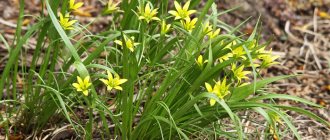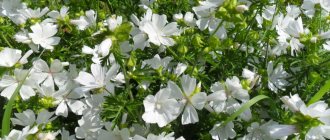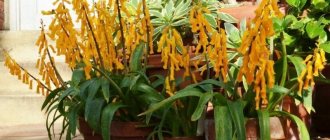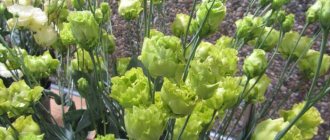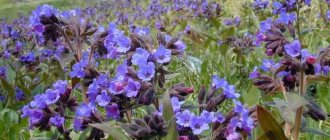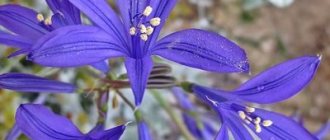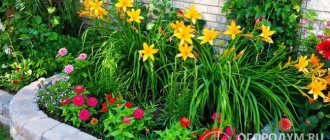Ecology
Flowers have always been one of the symbols of love. If someone is sick, they give him flowers. If someone is courting a woman, he presents her with a bouquet of flowers. If you are trying to apologize for something, you send flowers as a plea for forgiveness. When someone dies, flowers are presented to the deceased. Flowers are an integral part of various rituals in almost all cultures. It is important to know what flowers can be given and in what situations. The flowers listed below should not be touched at all. Find out more about very beautiful but poisonous flowers.
1) Aconite
© virginijavaidakaviciene
This plant is sometimes also called fighter, devil's helmet
or
Blue Rocket
.
The beautifully flowering plant belongs to the Ranunculaceae
and is most often found in the Northern Hemisphere. How dangerous is this flower? Arrowheads were made from some types of flowers of the family of fighters. They were used by many cultures for hunting and during wars. If the poison of this flower enters the stomach, it causes nausea, diarrhea, and vomiting. This may be followed by burning, tingling, and numbness of the face, mouth, and abdomen. At large doses, death occurs instantly.
Beautiful and terrible! 13 Deadly Flowers and Shrubs.
The topic of poisonous creatures of nature really interested me, so all week I was looking for something else that would be so poisonously interesting to tell the fairgoers about. And I found it! Such deceptive beauties can stand even a couple of meters from you.
Continuing the Sunday horrors - 13 of the most dangerous flowers and shrubs...
1. LILY OF THE LILY - Scientific (Latin) name Lilium convallium (“lily of the valleys”).
Lily of the valley may look beautiful and harmless, but it is highly poisonous. Of course, one or two of the plant's bell-shaped flowers will not cause serious harm, especially to adults. But if lily of the valley enters the body in large quantities, it causes pain in the mouth, nausea, vomiting, cramps and diarrhea. People with heart disease should be especially careful, as the toxins contained in lily of the valley slow the heartbeat and cause arrhythmia.
2. DAPHNE - Latin transcription of the Greek name for laurel - 'daphne', given by the name of the nymph Daphne, who, fleeing from Apollo who was pursuing her, was accepted by her mother, the earth goddess Gaia, and turned into a laurel tree.
Also known as wolfberry, lady's laurel or plant of paradise, wolfberry is a shrub, about 1-1.5 meters tall, that is most often grown for its beautiful and fragrant flowers. But all parts of this plant are poisonous, and the strongest concentration of poison is found in the juice and berries. Daphne contains meserine and daphnine, two strong toxins that cause abdominal pain, headaches, diarrhea, delirium and convulsions. If daphne berries enter the stomach, depending on sensitivity and quantity, a person may fall into a coma and even die.
3. BELLADONNA - translated from Italian as “beautiful woman.”
One of the most poisonous plants in the Western Hemisphere, Belladonna contains potentially lethal alkaloids called tropanes. In the old days, Italian ladies put belladonna juice in their eyes, the pupils dilated, and the eyes acquired a special shine. All components of the plant are harmful, but its beautiful berries pose the greatest danger, especially to children. Signs of belladonna poisoning or nightshade poisoning include dilated pupils, blurred vision, headaches, hallucinations, delirium and seizures. Atropine, a toxin found in belladonna, can be fatal to humans because it blocks the nervous system's ability to monitor breathing regulation, causes severe sweating, and can trigger cardiac arrest.
4. BRUGMANSIA - honor of the Dutch botanist Sebald Justinus Brugmans
The toxins that Brugmansia contains can be fatal to people and many animals. Known to be a powerful hallucinogen, Brugmansia should not be used as a drug as the risk of overdose is very high. Brugmansia plants contain variable amounts of tropane alkaloids such as atropine and scopolamine. The plant is known to be used in shamanic rituals by tribes in the western Amazon.
5. RHODODENDRON - from Greek “rose tree”.
It has been known since ancient times for being highly poisonous. Xenophon in his chronicles mentioned the inappropriate behavior of a group of Greek soldiers who ate honey collected by bees from rhododendron flowers. Rhododendron contains andromedotoxin, which causes nausea, severe pain, paralysis and even death. For example, Rhododendron Sims or Azalea is extremely poisonous, although it is often compared to a rose for its beautiful flowers. So beautiful and so cunning. Affects the heart, can lead to arrhythmia. An eaten azalea leaf threatens us with cramps and intestinal colic.
6. OLEANDER - consists of two words: “oleo” - odorous and “Andros” - one of the Greek islands where the sea nymph Nereid may have lived.
Oleander is known as one of the most poisonous plants on Earth; The flower is notorious in southern India, where it has been used as a murder weapon for centuries. Numerous toxic substances contained in oleander, including oleandrin and nerine, affect the nervous, digestive and cardiovascular systems at the same time. Oleander poisoning results in drowsiness, convulsions, and numbness. Fatal outcome is very likely. The sap of the plant causes skin irritation and severe inflammation of the orbits if it comes into contact with the eyes.
7. CROCUS - comes from the Greek word 'kroke' - thread.
Crocus or autumn saffron (the name “saffron” echoes the Arabic “zepheran”, that is, “yellow”) is one of the most poisonous plants in the world, to which people are most often exposed to dangerous effects. Crocus contains colchicine, a deadly substance that is used in the correct dosages for medicinal purposes. Unlike other toxins found in plants, colchicine has no antidote. Crocus poisoning leads to a critical decrease in blood pressure and cardiac arrest.
8. HORTENSIA - the name was given in honor of Princess Hortense.
All parts of the plant are deadly, especially flower buds. Eating a piece of hydrangea is like swallowing potassium cyanide, since the poisonous substance in this plant, hydrangine, is a cyanide. It causes suffocation, loss of consciousness, increased heart rate, convulsions, drop in blood pressure and death.
9. POINSETTIA - in honor of the plant collector, American senator and first ambassador to Mexico Joel Roberto Poinsett.
The milky sap of the plant is deadly. Poinsettias are not as toxic as other poisonous flowers, however, it is best that children and pets stay away from this plant. Consumption of milky juice leads to severe poisoning, accompanied by vomiting and diarrhea. Fortunately, deaths from poinsettia ingestion are rare.
10. DELPHINIUM - the name is associated with the shape of the flower; the Greeks, in particular Dioscorides, compared the buds with the head of dolphins (delphinos).
The entire plant is deadly, especially young leaves and mature seeds, which contain the highest concentration of toxic substances. These blue bells should never be tasted. Immediately you will feel nausea, a burning sensation in your mouth, and a slow heartbeat. You should consult a doctor immediately, since delay within 6 hours after poisoning is fatal.
11. Foxglove - the Latin name for foxglove is digitabulum - thimble, tip.
The entire plant is deadly, but especially the upper leaves, which are rich in digitalin, digitoxin, digitonin - substances that, although used in medicine, are deadly in large doses. The plant is toxic not only to people, but also to pets. The first signs of poisoning occur approximately 20 minutes after ingestion of the plant. These are nausea, vomiting, diarrhea (diarrhea). Depending on the dose, poisoning without emergency treatment can be fatal. Foxglove is especially dangerous for children.
12. KALMIA (mountain laurel) - named after the Swede Per Kalm, a professor at the university in Abo (now Turku).
The leaves, shoots, flowers and pollen of this close relative of azaleas and rhododendrons are deadly. Kalmia broadleaf is rich in andromedotoxins, which cause excessive tears, fluid from the nose and mouth, and then suffocation, kidney failure, convulsions, paralysis and even death.
13. KROTON (CODIUM) - named either in honor of the Greek. cities, or from Greek. k - mite, due to the similarity of the seeds in shape with the mite.
All flowers belonging to the euphorbia class are poisonous. Such flowers should be inaccessible to children and pets. Croton is from the Euphorbiaceae family. Flower juice that gets on the skin can cause a burn, and juice that gets into the blood can be fatal.
I am not a florist - flowers flatly refuse to live at home :) I am an admirer and an interested person. But in the future I will be more careful, because very often I put leaves and petals into my mouth, trying, so to speak, to taste the beauty =)
I would be happy to indicate the sources, if not for the rules on NM - no third-party links. The information is posted for general educational and educational purposes. And perhaps even cautionary ones.
2) Belladonna
© arenysam/Getty Images
This flower has many other names, for example, it is called Krasukha, Sleepy stupor
, or
Crazy Berry
, and he’s not to be trifled with.
The plant belongs to the nightshade
and is native to Europe, North America and Western Asia. All parts of the plant are toxic. If you eat the flower you will be in great danger. Children are often attracted to their berries because they look edible and even taste sweet. In case of poisoning, the following symptoms may be observed: dilated pupils, blurred vision, imbalance, headache, itching, facial flushing, slurred speech, confusion, hallucinations, delirium, convulsions. Death can occur if the body's reflex functions, such as breathing and sweating, are impaired and help is not provided in time.
Reproduction
Brugmansia reproduces by seeds and vegetatively.
Attention! The seeds are the most poisonous part of Brugmansia! Work only with gloves.
Brumgansia is propagated by seeds in January-March. First, the planting material needs to be soaked for a day in a solution of growth stimulants - “Kornevin”, “Epin” or “Heteroauxin”. Then it is advisable to scratch the dense surface of each seed a little with a knife or blade - this will allow germination to occur faster.
The soil mixture for sowing should be light and neutral. Bury each seed into the substrate by 0.5-1 cm and then cover it with film or glass and place it in a warm place (24 to 28°C).
Humidity and warmth are the main conditions for friendly shoots, which appear no earlier than in a month. During this period, sufficient lighting is very important for young shoots. With the seed propagation method, flowering will occur in 2-3 years.
Cuttings with rooting in perlite or water is a more popular method of propagating Brugmansias. In this case, be sure to cover the dishes with cuttings with glass or film, creating a small greenhouse.
The roots will appear quickly - within 2 weeks. Prepare the dishes for transplanting the young plant to a permanent place of residence.
3) Hemlock
© Alexandrum79/Getty Images
This poisonous flower belongs to the Apiaceae family and mainly grows in Europe and southern Africa. One species, Spotted Hemlock (Conium maculatum)
, extremely poisonous. This plant is native to Europe and is also found in western Asia and northern Africa. The plant contains large amounts of alkaloids, which can be fatal to both humans and livestock. One of the alkaloids is horse meat, which is very similar to nicotine. It interferes with the functioning of the central nervous system. Horsemeat poisoning may cause the following symptoms: muscle paralysis, leading to paralysis of the respiratory system. As a result, the heart and brain stop receiving enough oxygen, leading to death.
LiveInternetLiveInternet
Quote from Lud-Milka66
Read in full In your quotation book or community!
Flowers and Angels.
Larisa Kuzminskaya
FLOWERS AND ANGELS Flowers and angels are heavenly creatures... Flowers are like winged angels, And angels, like white flowers, are worthy of admiration and adoration. They do not expect retribution and retribution from Heaven, they are divinely pure. Flowers and angels are heavenly creatures... We are delighted with their beauty, Their habitat is gardens In the huge house of the universe, Above them the golden light shines from a distant star unknown to us.
MOON BOY Dedicated to my son Alan Avsaragov Moon boy with sad eyes With a silver ball in his hands, I stand before the sky with images, And I look for you on the clouds. The moon boy is a silver-winged angel, The young moon is my distant friend, You give me angelic power, You pour your life-giving light around. Moon Boy is a bright creature, Among the stars, in the radiance of the luminaries, You own the secret of the universe, You alone are infinitely dear to me. Come to me in your radiance, Shed light on my soul, I ask for it as an alms, For so many long lonely years. A lunar boy with sad eyes, With a silver ball in his hands, I stand in front of the sky with images, And I look for you in the clouds.
FLOWER ANGELS Flower angels are angels of light, They come to us in the morning with the rays of dawn, They sit on asters, tulips, peonies, Opening the buds with their love, Crystals of dew are scattered on them, They sparkle in the petals of delicate roses. And rainbows are sprinkled on flower beds and paths, And the rays of the sun are like crumbs of gold. From small bright glass bottles They pour light scents into the depths of the buds, And hiding in the bushes of open roses, They release dragonflies and butterflies from brocade bags into the garden and meadow, And they flutter and fly with delight, They transfer pollen from flower to flower, And angelic drink miracle juice on flowers. Flower angels are angels of light, I really want the sun, I really want summer!
CORDELIA THE FLOWER FAIRY A flower fairy in a chiffon dress, A cameo shining in emerald bows. Her eyes are so bottomless, the color of amethyst, And her wings are like golden silk. Bumblebees and dragonflies fly over the field, The most delicate roses bloom in the gardens, And bright butterflies over the boy's meadow - And all these are fairies' flower creations, Cordelia has an angel and an elf as friends, And her dresses are like a train of clouds, She lulls them to sleep with sweet dreams, entangling their legs flowers - vines. Such a mischievous fairy of flowers comes to earth with the dawn lightning, has fun all day, leaves in the evening, lighting night violets for us.
SILPHIDE The sylph lives in the cup of a flower, And sometimes travels on the clouds, She is protected by the elements of the air, She composes fairy tales and poems. In the morning it flutters smoothly over the meadows, looking like an origami bird, and in the morning it descends into our garden, eating dew and grapes for dinner. Then she goes to sleep in a flower bud - The divine priestess of flowers and herbs, And she probably has colorful dreams, In which butterflies and grasshoppers frolic. And in the morning she flies into the fields again, And both heaven and earth are glad to see her, And so lovely is the slender goddess, She is the heroine of ancient legends. In the circle of sisters, sylphs, flower fairies, Sings divinely, as Orpheus himself would sing. And the earthly and heavenly worlds listen to her, And all the flowers sing along to that song.
THE HOUSE OF ANGELS - A HEAVENLY WONDERFUL GARDEN The home of angels is a heavenly wondrous garden, There flower petals, as if in a snowfall, Whirl like white snowflakes, There the lightest fluffs of dandelions Soar like the feathers of sacred white birds, Touching the angelic lovely children's faces. The dwelling of angels is a heavenly marvelous garden, Honey grapes grow in the garden, Levkos, lilies, and tulips bloom. Here angels in the thick foliage of plane trees swing in openwork hammocks and enjoy the magical singing of the birds. The dwelling of angels is a wonderful heavenly garden, There are starfalls in the sky day and night, There white owls sit under the stars And carefully keep the angelic secrets. We cannot get into this wonderful world, And we are sad within the walls of our apartments.
TODAY IS A HOLIDAY FOR THE GARDEN AND THE SOUL Today all the flowers have bloomed, As if angels had descended from the sky, And in the diversity of this beauty, Divine and virgin nature. White peonies are like clouds, And asters are red like the sky at sunset, A tulip is filled with dew like a glass, A violet in a velvety blue dress. Today is a holiday for the garden and the soul, Flowers and angels have descended to us from paradise, And in this fabulous real mirage, earthly beauty has merged with heaven.
1.
2.
3.
4.
5.
6.
7.
8.
9.
10.
4) Oleander
© User10095428_393 / Getty Images Pro
This very beautifully flowering plant is extremely poisonous, although it is widely used in landscape design and is even planted in school yards. All parts of the plant are toxic, but despite this, it is widely cultivated. The plant is said to be native to Portugal, Morocco and Mauritania. The toxicity of the flower is quite high, so if you hear about oleander-based medicines, this may raise suspicions. Symptoms of oleander poisoning include vomiting, diarrhea, excessive salivation, abdominal pain, rapid heartbeat, drowsiness, trembling, convulsions and coma.
5) Datura
© Jupiterimages / Photo Images
There are nine representatives of the Datura
, the distribution of which in nature is unknown. Most of these plants can be found in the USA and Mexico. All nine species contain alkaloids that can cause death. For a long time, the plant was used to produce poison and as a hallucinogen. In Europe and India, there are known cases of murders and suicides using the poison of this flower. Today, in some countries, the purchase, sale and cultivation of Datura is considered illegal.
Conditions of detention
In winter, a tub of brugmansia is placed in a cool room (up to 15°C) - on a loggia, an enclosed balcony or in a winter garden - this will guarantee that in the spring the tree will again be covered with huge fragrant “angel trumpets”, and its leaves will not fall off .
Moreover, it will continue to bloom for some time, even at +10°C, which not every indoor plant with an intense aroma can boast of.
Watering during this period needs to be moderate, without drying out the substrate. Periodically check for pest damage
Some gardeners believe that Brugmansia should be given absolute rest in winter - at a temperature of +5°C and in a dark place. In this case, the leaves from the bush will be completely dropped , and the recovery period in the spring will pass much faster. In dark conditions, watering also does not stop: the roots of the plant should not dry out.
If you want to learn about the distant homeland of the Uzambara violet plant and the natural habitat conditions of this beautiful flower, read our article.
Our material will tell you how to make spathiphyllum bloom.
Is it possible to grow pineapple at home? Find out at the link: https://sad-doma.net/houseplants/decorative-leaf/kak-vyrastit-ananas.html
With the onset of spring, Brugmansia simply needs to spend time outdoors, in a shaded place, to get used to active sunlight.
The plant will get stronger , gain strength, and in the future will be able to withstand prolonged exposure to ultraviolet rays. A place protected from the wind on a terrace or open loggia, bright but protected from direct rays, is suitable for this.
Watering and fertilizing
Water the Brugmansia abundantly with soft, warm water until the excess comes out into the pan, even twice on hot days. Do not stop watering in winter, just reduce the volume by about half.
Brugmansia, like most beautifully flowering plants, is very moisture-loving . In addition, it is also a large consumer of nutrients, so it is unlikely that it will be possible to grow it without regular and generous feeding.
In the spring, when replanting a bush, immediately apply a sufficient amount of long-lasting fertilizer. And from May to August, feed 2 times a week with liquid fertilizer for flowering plants (add to water for irrigation).
Transfer
In the first year of life, Brugmansia grows so intensively that it has to be replanted several times as the rhizome fills the earthen coma. Then transplants are done only early in the spring or are limited to changing the top layer of soil.
Drainage must be arranged to avoid stagnation of water, which can cause the death of even an adult plant.
Plastic rather than clay pots are ideal for this shrub The tub must be stable and large enough (otherwise you will have to water very often).
The growth of Brugmansias has a beneficial effect by adding clay granulate, which retains moisture and nutrients (up to 10% of the total volume).
7) May lily of the valley
© Kichigin
One of the most beautiful forest flowers - lily of the valley - is actually not as harmless as it seems. It usually grows in cool regions of the Northern Hemisphere, and some of its varieties are used as garden flowers. Despite the fact that the medicinal properties of lilies of the valley are known, this flower is very toxic. It is believed that it can strengthen memory and even give someone common sense. The truth is that all parts of this flower are poisonous; it has a large supply of glycosides that can disrupt the functioning of the heart.
Angelonia - a flower with an angelic character
Angelonia Meet Angelonia.
Initially I was attracted by the title. Like many people, I thought it came from the word “angel.” But no! It comes from the name of the "angelon" people in Caracas, Venezuela. This beauty also grows in South and Central America, in Mexico. In warm countries it is a perennial, but in our country it is an annual or indoor flower. There are several varieties: both tall (60 cm) and lower (20-30 cm). I have Serenita. Compact form, up to 30 cm tall, color - purple, crimson or white. Angelonias are also called “poor man’s orchids” because of the similarity of the flowers to orchid flowers. Personally, I don’t find much similarity, but that’s good: orchids are “not my flowers.”
This flower captivated me with its unpretentiousness. Truly angelic character. This can be especially appreciated in hot climates. My little angels forgive me for “forgot to water” and “didn’t feed me.” Agree - this is important! They also grow well in the scorching sun, both in a flower bed and in a plastic flower pot. At our + 30 +40, not a single plant withered, requiring watering. Aphids do not settle on it, snails do not eat it. (Or am I just so lucky!?). Seriously, angelonias are very resistant to diseases and pests.
Perfect for rockeries and alpine slides. Look beautiful with stones and require a minimum of soil. Angels grow wonderfully in a container. They do not require cutting, pinching or shaping. If you cut off a faded peduncle, the angelonia immediately produces a new one. Grows in a neat, compact bush. When sown in mid-February, it blooms at the end of June and blooms until frost.
Disadvantages include slow growth at the seedling stage. I sow in mid-February at the same time as petunias and lobelias. I spread the seeds on the surface of the soil and do not sprinkle them, as they need light. I water it carefully, cover it with film and put it in a warm place (~22 degrees).
Shoots appear in five to six days. I remove the film and put it under the phytolamp. Temperature ~ 18-19 degrees. And so on until the beginning of April, then on the windowsill.
March 29 For picking, I expect not 2 leaves, but 4-6. Angelonias have small roots, compact plants, and are easy and pleasant to work with.
April 22
Tops and roots
The pick is over
The seedlings are not capricious and tolerate picking well. In mid-May, I planted the rosemary, partly in a flower bed, partly in flower pots with neutral soil and acidic soil (for hydrangeas). Be careful, angelonias do not tolerate frost!
May 31 June 24 First flowers
Since the beginning of July, the angels have been showing themselves in all their glory.
Since the beginning of July, the angels have been showing themselves in all their glory.
These were pots with acidic soil. The flowers turned out lush and not very tall. Although we gained the promised 30 centimeters.
Neutral ground
In the flowerbed
Angelonia can also be grown as a young plant if you bring it indoors for the winter and care for it like a houseplant. Also in this case, you can propagate it by cuttings. I will describe this process in my next work, in winter...
I hope you enjoyed the angelic nature of this pretty flower. Thank you.
The online store Seedspost.ru invites you to familiarize yourself with the Flower Seeds catalog, where you can choose and purchase any seeds you like, including Angelonia Serenita
10) Lakonos
© Aviavlad/Getty Images
And the last one on our list is Lakonos
- a beautiful, but rather poisonous flower. The flowers of this plant are the only part of it that is considered poisonous and can cause a lot of harm. If the flower is swallowed, the victim will experience nausea and vomiting. Symptoms may then include heavy sweating, cramping, extreme weakness, shaking, diarrhea, bloody vomiting and convulsions. In case of severe poisoning - slow breathing, dizziness, seizures, coma and death.
Description
The tree has a branched trunk with large leaves arranged alternately. Completely unusual in shape, single or double velvety flowers reach 10-45 cm in length and can be in all shades of white, yellow, pink, orange, green or red.
In most species, the flowers have a strong, pleasant aroma, which is most noticeable in the evening and at night. The period of abundant flowering lasts from June to October, with the most fragrant flowers appearing in August. Sometimes about a hundred flowers bloom on one tree!
